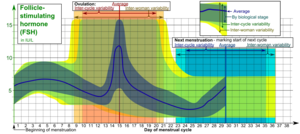ملف:Hormones estradiol, progesterone, LH and FSH during menstrual cycle.png

حجم هذه المعاينة: 304 × 598 بكسل. الأبعاد الأخرى: 122 × 240 بكسل | 244 × 480 بكسل | 390 × 768 بكسل | 520 × 1٬024 بكسل | 1٬846 × 3٬634 بكسل.
الملف الأصلي (1٬846 × 3٬634 بكسل حجم الملف: 918 كيلوبايت، نوع MIME: image/png)
تاريخ الملف
اضغط على زمن/تاريخ لرؤية الملف كما بدا في هذا الزمن.
| زمن/تاريخ | صورة مصغرة | الأبعاد | مستخدم | تعليق | |
|---|---|---|---|---|---|
| حالي | 07:09، 17 مايو 2012 |  | 1٬846 × 3٬634 (918 كيلوبايت) | Mikael Häggström | {{Information |Description ={{en|1=d}} |Source ={{own}} |Author =Mikael Häggström |Date =d |Permission = |other_versions = }} |
استخدام الملف
الصفحة التالية تستخدم هذا الملف:
الاستخدام العالمي للملف
الويكيات الأخرى التالية تستخدم هذا الملف:
- الاستخدام في da.wikipedia.org
- الاستخدام في el.wikipedia.org
- الاستخدام في en.wikipedia.org
- الاستخدام في id.wikipedia.org
- الاستخدام في mk.wikipedia.org
- الاستخدام في pl.wikipedia.org
- الاستخدام في ta.wikipedia.org
- الاستخدام في th.wikipedia.org
- الاستخدام في uk.wikipedia.org
- الاستخدام في vi.wikipedia.org
- الاستخدام في zh.wikipedia.org






